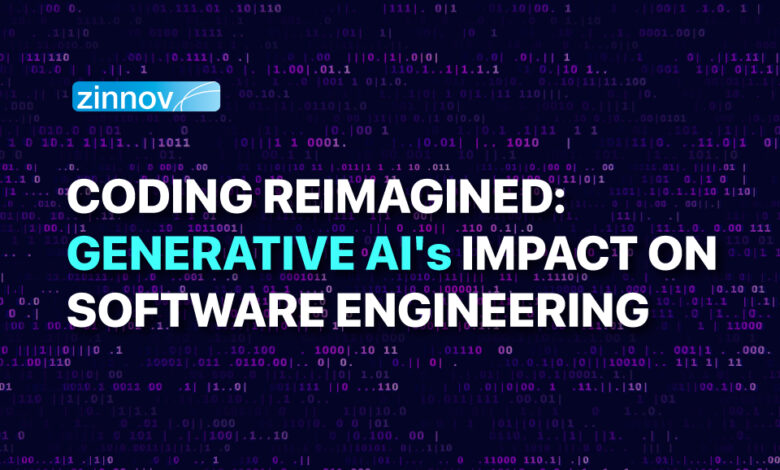Coding Reimagined: Generative AI’s Impact on Software Engineering | nasscom

The software development world is abuzz over Generative AI – and for good reason. This game-changing technology promises to transform the way engineers work, ushering in a new era of efficiency, innovation, and productivity.
But what exactly is Generative AI, and why is it such a game-changer? Simply put, it’s a type of Artificial Intelligence that can generate text, images, videos, and code by learning from patterns in existing data. It leverages Large Language Models (LLMs) to understand and generate human-like content – in a plethora of formats including text, image, video, and code – enabling it to suggest code completions, catch errors, and even generate entire functions or modules from scratch.
The potential benefits for software development are staggering. Generative AI can help developers work faster and more efficiently, reduce error rates, and free up time for more strategic tasks. It’s like having a super-powered digital assistant at your beck and call, ready to tackle mundane chores and let you focus on the bigger picture.
Securing Sensitive Data: Addressing the Risks
Of course, with any new technology comes a set of challenges and concerns that must be addressed head-on. In the case of Generative AI, one of the biggest worries is the potential for exposing sensitive information or introducing vulnerabilities through the generated code.
Picture this: your company deals with a lot of confidential data, and you’re considering using a Generative AI coding tool like GitHub Copilot. But then the nagging fear sets in – what if that tool accidentally leaks some of your precious trade secrets through the code it generates? It’s a scary thought that has many organizations hitting the brakes on full-scale adoption.
Fortunately, there are ways to mitigate these risks and still reap the rewards of Generative AI. It all starts with implementing robust safeguards and being proactive about security. For industries with stringent data privacy requirements, like Banking, Financial Services, and Insurance (BFSI), the recommendation is to use on-premise Generative AI tools like Codeium and Tabnine to prevent any potential data exposure.
And for those using Cloud-based tools like GitHub Copilot, there is the option to disable training data logging. It is all about finding that sweet spot between harnessing the power of Generative AI and maintaining the integrity of your sensitive data and code.
Generative AI in Action: Real-World Applications
While some organizations are still dipping their toes into the Generative AI waters, others are diving in headfirst and exploring practical applications across various industries.
Right now, most companies are focused on ‘low-risk’ assistive use cases that help developers work more efficiently. Think code summarization, information retrieval, content generation, and automated testing processes. But that’s just the tip of the iceberg.
Generative AI is also proving its mettle in accelerating existing code updates and facilitating collaboration among engineering teams. Imagine being able to work seamlessly with your colleagues, with an AI tool acting as a bridge, streamlining communication and boosting productivity.
But it’s not just the tech giants that are embracing this revolution. Industries like Energy & Utilities are using Generative AI for hardware/software development, coding, and test automation. Financial institutions are prioritizing use cases such as information retrieval, content generation, summarization, and building assistive platforms for financial advisors.
And even Technology Service Providers are getting in on the action, using Generative AI to bridge knowledge gaps between legacy and modern codebases – it’s like having a translator who can help you work with different programming languages seamlessly.
However, in risk-averse domains like Banking, Finance, Pharmaceutical, and Healthcare verticals, widespread Generative AI adoption may take a bit longer. These industries have strict regulatory requirements, and introducing new technologies can be akin to navigating a minefield. But that doesn’t mean they are sitting on the sidelines – these sectors are focusing on low-risk operational use cases for now, dipping their toes in before taking the plunge.
Boosting Productivity and Reshaping Teams
Generative AI’s impact on productivity is already being felt across organizations that have implemented these tools. A recent study by Zinnov and Ness Digital Engineering found that using Generative AI for existing code updates led to a whopping 70% reduction in task completion time. That’s like finishing a marathon in half the time it usually takes!
But it’s not just about speed – companies like Schneider Electric reported a 20% drop in basic coding errors and defects, with productivity gains ranging from 20% to 50% across experience levels. As one industry leader put it, “Training our engineers on prompt engineering unlocked immediate productivity benefits from Generative AI.”
These results are also showing up in other metrics, like faster commit rates, shorter code review times, and – perhaps most importantly – happier developers overall.
But the ripple effects of Generative AI extend beyond individual productivity gains. This technology is poised to disrupt the traditional pyramid-shaped hierarchy of software engineering teams, where there are many junior engineers at the bottom and fewer senior developers at the top. Instead, we might start seeing flatter, diamond-shaped structures emerge. In this model, senior developers with deep contextual knowledge will leverage AI tools to amplify their productivity, while the need for junior engineers may diminish.
This shift will require a rethinking of learning & development strategies, with a greater emphasis on cultivating domain mastery over mere technology skills. It’s about transitioning from being a jack-of-all-trades to a master of one – in the age of Generative AI, it’s the specialists who will truly shine.
Navigating the Future with AI Centers of Excellence
As software development transforms with Generative AI, organizations must adopt a strategic approach to navigate the opportunities and challenges presented by it. This includes maintaining robust safeguards, fostering a culture of continuous learning and adaptation, and – perhaps most importantly – establishing dedicated AI Centers of Excellence (COEs).
These COEs can play a pivotal role in advising, guiding, and overseeing AI projects within an organization. They serve as the vital bridge that connects executive decision-making with the pragmatic implementation of AI initiatives, ensuring that Generative AI is integrated in a secure, compliant, and effective manner.
The COE can become the central hub for expertise, advising teams on the most effective ways to leverage Generative AI while mitigating risks and upholding industry standards. It is the lynchpin that will help an organization unlock the full potential of this transformative technology.
The future of software development is being reshaped by Generative AI, and the time to embrace this revolution is now. By addressing concerns head-on and exploring practical applications, any organization can ride the wave of change and emerge as a leader in the new era of efficient, innovative, and productive coding.



